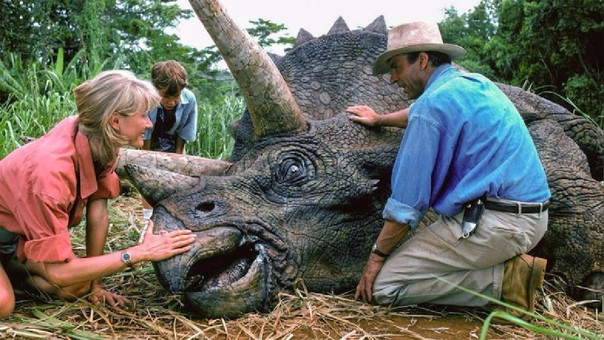It’s a film that’s been revered and adored by so many people; one that captured the imaginations of countless children; revolutionised the use of CGI in cinema and set a new benchmark for blockbuster success, by all measures a true ‘classic’. And until a few days ago, I had never seen it before.
In celebration of Jurassic Park’s 25th Anniversary this year, Vue have been holding special screenings of the film. So, out of the fear of having my ‘film buff’ card revoked otherwise, I went along to see whether Jurassic Park still lives up to the hype.
I am most definitely pretty late to the party here, but in 2018 Jurassic Park is 100% deserving of its praise. It holds up exceedingly well, the visual effects show little signs of ageing and the distinctively 90s look of the film only serves to enshrine the film as a product of its time, and a truly ground-breaking one at that.
In spite of having made a name for himself as one of Hollywood’s most successful filmmakers, prior to the release of Jurassic Park Spielberg’s previous few films had been somewhat lacklustre. Indiana Jones and the Last Crusade (1989) had been a rather safe sure-bet sequel, and Always (1989) and Hook (1991) were two films considered lesser within the director’s filmography. By 1993 Spielberg had a fair bit to prove in order to maintain his place as a master of blockbuster filmmaking, and the immense achievement of Jurassic Park was integral to re-establishing Spielberg as one of Hollywood’s greatest directors.
Initially, Jurassic Park was intended to feature a combination of practical effects created by Stan Winston and stop-motion work of effects pioneer Phil Tippett, who had contributed effects work to Robocop and Star Wars. During the course of production, Spielberg became increasingly impressed with the capabilities of computer imagery and began integrating it into the film. Tippett’s role evolved into using his animation expertise to advise computer effects artists on how to get the dinosaurs just right.
Computer generated imagery had been used in films before Jurassic Park, but never so convincingly and to such great extent. Previously CGI had been used to create an eerie or otherworldly effect in movies like Terminator 2, but now CGI needed to look as close to realistic as possible.
“I’m going for total realism,” said Spielberg about creating the VFX creatures, “as opposed to anything that hypes the wonder. There are no lights around my dinosaurs, they’re in the flesh, walking around in broad daylight, right in front of you, making no excuses for themselves. They’re as close to living animals as any I’ve ever done.”
Ultimately the dinosaurs in the movie are the result of using a mixture of CGI, stop-motion techniques, full-scale animatronics and practical effects. And for the most part, the dinosaurs do look startlingly real, particularly in scenes set at night such as when the park owner John Hammond’s (played by Richard Attenborough) two grandchildren are trapped in a car under attack from a giant T-Rex.
Here the low light and use of shadow enhance the terror of the dinosaur and, combined with the rain VFX, successfully obscure any perceivable flaws in the computer rendering that might jeopardise the creature’s realness.
The sound design also plays a huge role in making the dinosaurs feel viscerally real, and Gary Rydstrom creatively manipulated various animal noises, ranging from geese squawks to mating turtles to create the dinosaur’s sounds. The blood-curdling, bone-chilling T-Rex roar was based on the sound of a baby elephant. And I can’t forget to mention John Williams’ iconic and majestic score that beautifully encapsulates the sense of awe and terror the dinosaurs invoke.
Filmmaking has come a long way since 1993, but Jurassic Park showcases some of the best talent Hollywood had to offer at the time creating a film with a great deal of passion and sincerity – something that the franchise’s instalments are rather lacking in – and that’s what makes it such a compelling film today. Yes, the capabilities of CGI and special effects might be better today, but they owe a massive debt to the pioneering work achieved by the crew of Jurassic Park.
It may not be a timeless film and some of the plotting may now feel a tad formulaic, but it’s a film that preserves a pivotal moment in film history. Like the mosquito preserved in amber that holds the key to unlocking the dinosaur DNA, it’s an artefact of cinema that shows us how a perfectly crafted classic movie is made.
Also, it had Jeff Goldblum being as Jeff Goldblum as he can be, blessing us with his endlessly meme-ability, and that alone is more than any of us deserve.
Elle Bennett

